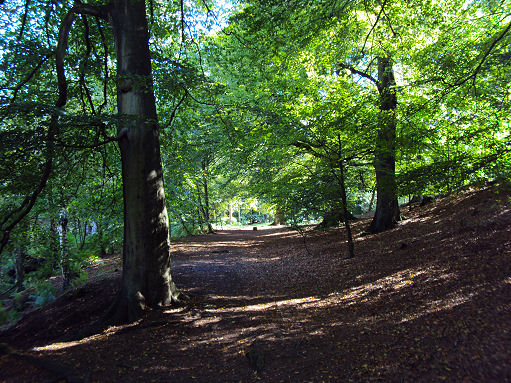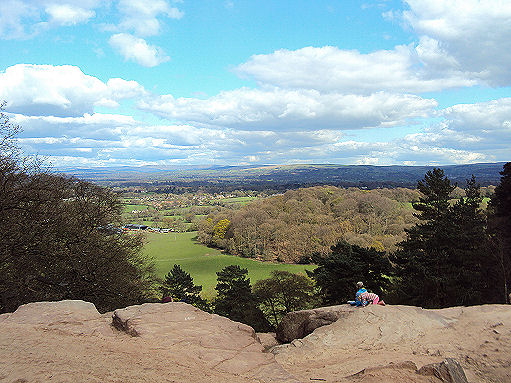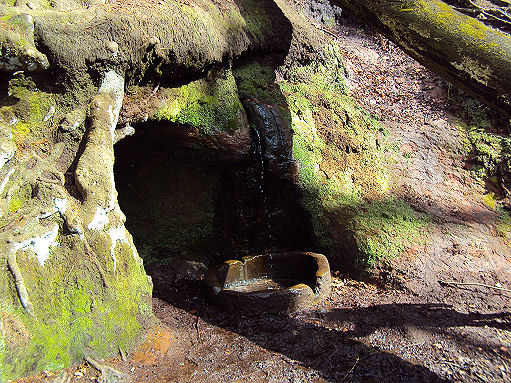Alderley Edge
Alderley Edge, a dramatic red sandstone escarpment which reaches to 600 feet (160 metres) above the surrounding landscape, offers impressive views. On a clear day it is possible to see Manchester, Stockport and the Pennine Hills beyond.

The wooded escarpment is designated an Site of Special Scientific Interest due to its geology. Alderley Edge escarpment has been a site of copper mining for many centuries. The Alderley Edge Mines consist of an extensive series of workings with a number of entrances. There is evidence to suggest that mining first took place there in the Bronze Age and in Roman times. A fourth century Roman coin hoard was found in an abandoned shaft at the Engine Vein mine in 1995. An archaeological excavation was undertaken and timbers were revealed which were carbon-dated to the last century BC.
An ample National Trust car park is provided, near to which stands the Wizard restaurant, which provides excellent meals.
Beech woodland at Alderley Edge

Alderley Edge has long had associations with wizards and witches and is shrouded in myth and legend. The folktale regarding the Wizard of the Edge relates the tale of a Mobberley farmer crossing the Edge whilst taking a fine white horse to market. The farmer encountered an old man, with a long white beard dressed in strange clothing. On recieving an offer to purchase the horse from him, the farmer refused, to be told he would not sell the horse at market and furthermore, would sell it to him before the day was out.

The farmer failed to acquire a purchaser at the market and on his way home, the legend relates, encountered the strange old man again, who bade him follow him to a large rock. When the wizard touched the rock with his wand two large iron gates appeared and opened before his eyes. Inside the cave lay sleeping knights and their horses. All the horses were milk white. In the innermost cave the wizard is said to have pointed out a large pile of gold and jewels, telling the farmer to take his payment for the horse. The wizard explained that one day in the future, when England stood in great danger the army would wake and ride out onto the Cheshire plain to save the country.
The Druid's Circle at Alderley Edge, a folly that probably dates to the 19th century

The Druid's Circle is situated in the woods on the path between Stormy Point and the Beacon. The Druid's Circle is not a true prehistoric stone circle, it is around 200 years old and has no earth lines registered around it. Alan Garner claims that his great-great grandfather Robert Garner created the circle. The Holy Well has pagan links and possibly dates from Anglo-Saxon times. In 1843, Robert Bakewell told how the waters from the well, “are said to be a cure for barrenness.” As well as this he reported how a large boulder fell from the Holy Well Rocks above it around 1740, and “a woman and a cow are said to have been buried under it.” A few yards below it is the Wishing Well, also known as the de Trafford Well which also has pagan links, the hollow just by it is a trial working was probably made by miners searching for copper, although Alan Garner has suggested that the cave may have been a result of the Romanticisation of the Edge in the eighteenth century, with the cave being cut to ressemble hermit's cell.
The Wishing Well, or de Trafford Well

The highest point on the Edge was originally a Bronze Age burial mound. It was later used as a fire beacon site which would have been lit as a signal to warn of the imminent invasion. Alderley Edge is wreathed in legend. It was one of the many legends associated with the Edge which inspired Alan Garner to write his book The Weirdstone of Brisingamen.
In the 1960s the Edge had a reputation as the meeting place for a witch's coven (which also occurs in Garner's tale). The coven was broken up, however, and in the present day there are more visitors interested in seeing the sights of the Edge than in practicing magic. Some come looking for the iron gates, which are supposed to lie between Stormy Point and the Holy Well, though no one has ever found them.
The Wizard's Well
The Wizard's Well is formed by a natural spring close to Castle Rock.

Water springs from a huge rock and runs down into a stone trough. Carved into the rock above the well is the bearded face of a wizard, under which is an inscription which reads 'Drink of this and take thy fill for the water falls by the Wizhard's will'. The wizard's face is said to be the work of Robert Garner, a local stone mason and the great-great-grandfather of local author Alan Garner (famous for his book The Weirdstone of Brisingamen). The wizard's face appears to be older than the inscription which is thought to have been added sometime later by a Mr Simeon Slater of Leigh, Lancashire. Another 'face' can be seen a few yards along the track towards Castle Rock.
A walk at Alderley Edge
Distance- 3.5 miles
*Commencing the car park turn towards The Wizard pub. Turn right and then left at the National Trust signpost. Take the left fork in the track to the Church Quarry. Turn left and follow the track and pass through the gate on the right (not the Hare Hill path).
*Continue along the track on your left until reaching a copse of pine trees, take the path on the left to Old Alderley Quarry. Turn left and follow the track until reaching a fence on your left. At this point take the path on the right which backtracks slightly. Upon reaching the end of this short track turn left. A few yards on take the track to the right and follow the fence to the left past the Wizard's Hole until you can see a clearing below and to your right. On reaching the clearing, ascend the track and continue until arriving at larger clearing.
* Follow the path and climb up to the long outcrop of rock. Take the path to the left, marked with a disabled sign which passes the Druid's Circle on your left and follow it to the end keeping to the right just after the Druid's Circle. On reaching the Beacon, climb the mound on which the monument is situated then follow the descending track straight ahead. Take the second path on the left which has shallow steps. This path passes the Holy Well and Wishing Well, follow this path to the end. On reaching a T-junction, turn right and then right again after a few yards.
*Continue along this path until reaching the Wizard's Well on the left. Then turn and backtrack until reaching an overhang of rock. Take the steps to the right and then the path to the left a few yards further on which leads to Castle Rock. Take the path on the left which skirts the field until reaching a stone wall. Follow the path around the wall and take the path on your right which follows the stone wall and runs behind the Beacon. Take the path straight ahead to arrive at crossroads. Continue straight ahead until reaching the Engine Vein Quarry. Finally take the path which is straight ahead to return to the car park.
Follow the Country Code
*Be safe- plan ahead and follow any signs.
Protect plants and animals and take your litter home.
Keep dogs under close control
Leave gates and property as you found them
